Every year, mountaineers from around the world set out searching for one goal: to reach the summit of Aconcagua. The highest mountain outside of Asia, a treasure of South America, ranks second on the Seven Summits circuit, just behind Mount Everest.
Reaching an altitude of nearly 7,000 meters is a major challenge and requires determination. In this guide, we will cover how to prepare physically, what technical skills and equipment are needed to reach the summit of Aconcagua, as well as sustainability tips to help preserve the region. We will also show you how to choose the best expedition to experience a transformative high-mountain adventure.
Table of Contents
- Aconcagua: A Giant of the Americas
- The Routes of Aconcagua
- Wonders of an Aconcagua Expedition
- Acclimatization: The Main Challenge of Climbing Aconcagua
- How to Prepare Physically and Mentally for Aconcagua
- Physical Training for Aconcagua
- Nutrition Routine: What to Eat Before and During the Aconcagua Expedition
- Daily Planning
- Nutritional Supplements: Practicality and Energy in High Mountains
- Train Your Mind to Endure Discomfort
- Technical Skills Needed to Reach the Summit of Aconcagua
- Gear and Technology: What to Pack for an Aconcagua Expedition
- Layered Clothing
- Footwear
- Accessories
- Gear
- The Importance of Choosing a Suitable Sleeping System to Climb Aconcagua
- Backpacks
- Technology
- First Aid Kit
- Sustainability on Aconcagua
- How to Choose an Agency for Your Aconcagua Expedition
Aconcagua: A Giant of the Americas
Technical information:
Location: Aconcagua Provincial Park is located 180 km from Mendoza, in Argentina Altitude: 6,961 m Activities: trekking and mountaineering Climate: arid Level: the normal route does not require advanced technical skills, but the high altitude demands both physical and mental preparation Season: from November 15 to February 15 Documentation: it is necessary to obtain a climbing or trekking permit (depending on the activity), issued by Aconcagua Provincial Park, in addition to contracting an international insurance policy that includes helicopter evacuation coverage.
See guidelines and tips for saving on the Aconcagua climbing permit.
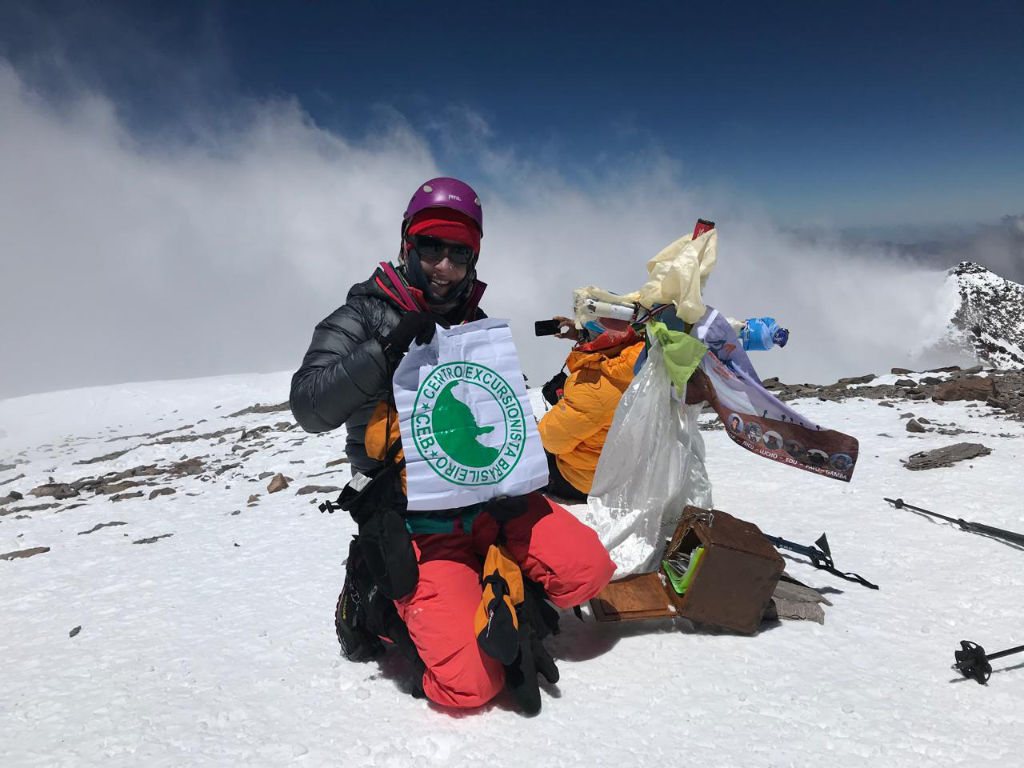
Aconcagua Summit – Photo: Fernanda May
The Routes of Aconcagua
The most well-known ascent route is the northwest one, a trekking-focused option, but there are two other alternatives offered by agencies such as Grajales Expeditions, the first company to obtain a license to offer services on Aconcagua and a partner of Gear Tips Club:
- Normal Route: as the most popular route, it attracts the largest number of climbers during high season. It goes through the Horcones Valley.
- Polish Traverse Route: also known as the “360”, it starts in the Vacas Valley and ends in the Horcones Valley. It offers a panoramic view and is less crowded than the normal route.
- Polish Glacier Route: known as the “Direct Route” of the Polish Glacier, it requires knowledge of glacier travel and rope handling. This route is ideal for those with technical skills and an adventurous spirit.
The Beauty of an Aconcagua Expedition
The iconic arrival at the summit of Aconcagua is eagerly anticipated by climbers. However, throughout the journey, Aconcagua Provincial Park offers stunning beauty, such as the sunrise and sunset framed between the surrounding mountains, with Aconcagua always in the background.
Fernanda May, mountaineer and sports physician, went to Aconcagua in 2018 with a travel agency. She says the arid landscape sets it apart from other high-altitude trekking approaches, where there is usually plenty of vegetation. “What stands out the most in the landscape are the surrounding mountains and the view of Aconcagua.”
Sunrise and Sunset
Among the highlights of the destination, Fernanda points to the sunrise and sunset at Nido de Cóndores—where the second camp is located and the routes intersect—as an unforgettable experience. “During the season I went to Aconcagua, everything was covered in snow, and the sunlight reflected off it, creating a dazzling view. From there, you can also see the entire route to the summit.”
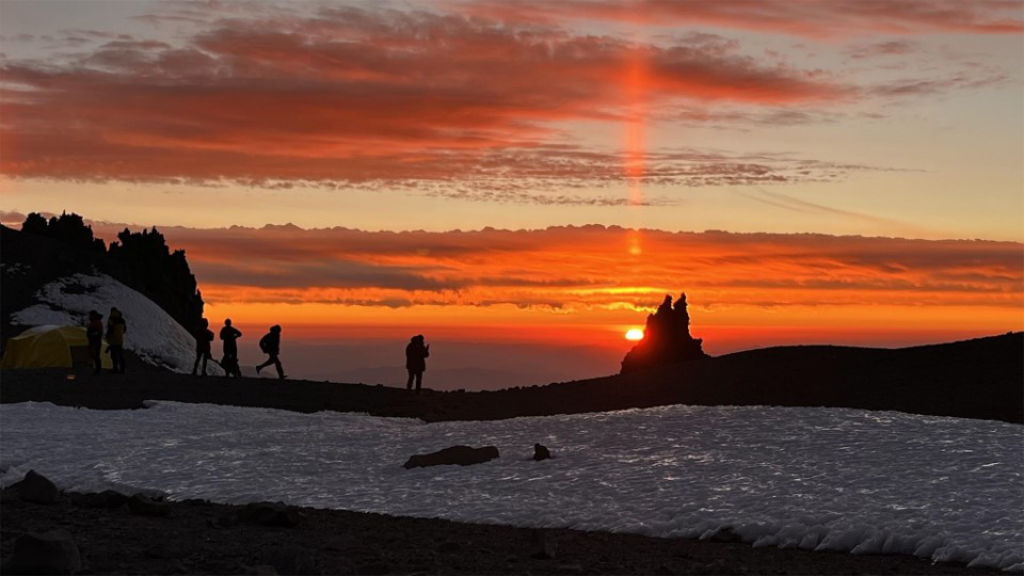
Photo: Bruno Alvarenga
Plaza de Mulas
The trek to Plaza de Mulas covers 18 km through an arid valley with limited scenery. However, the arrival is iconic thanks to the sight of tents and a 360-degree view that includes Aconcagua, Cerro Bonete, and other surrounding peaks.
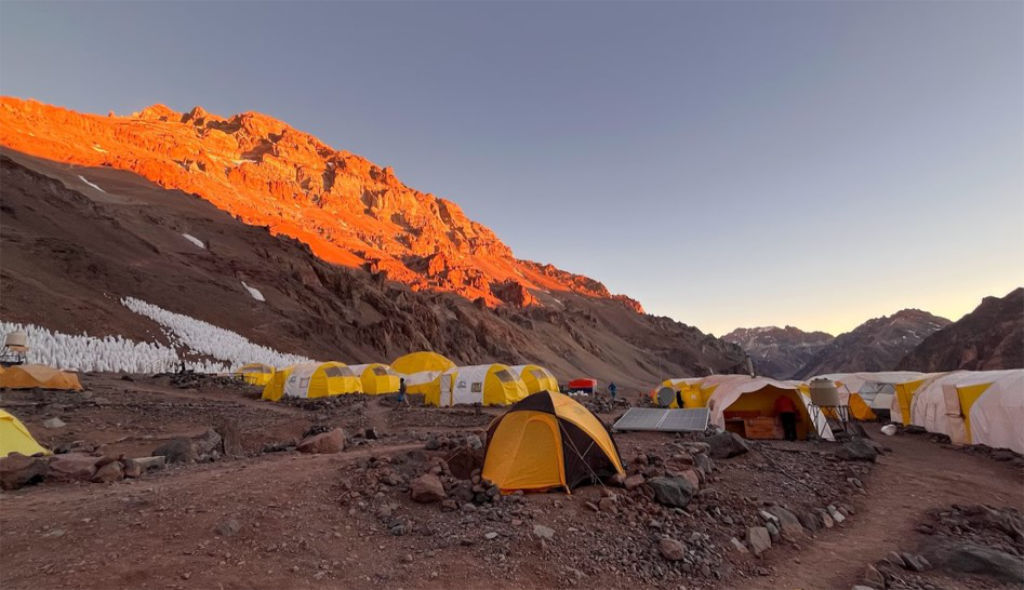
Photo: Bruno Alvarenga
Manu Bustelo, from Grajales Expeditions, also highlights the local cultural richness of Miguel Doura’s art gallery, set up in a tent at Plaza de Mulas and recognized by Guinness World Records as the highest contemporary art gallery in the world.
Plaza Francia
From Plaza Francia, a spot used by agencies for acclimatization, it is possible to view the mountain from another side. According to Fernanda, the view and the scenery from the valley are breathtaking.
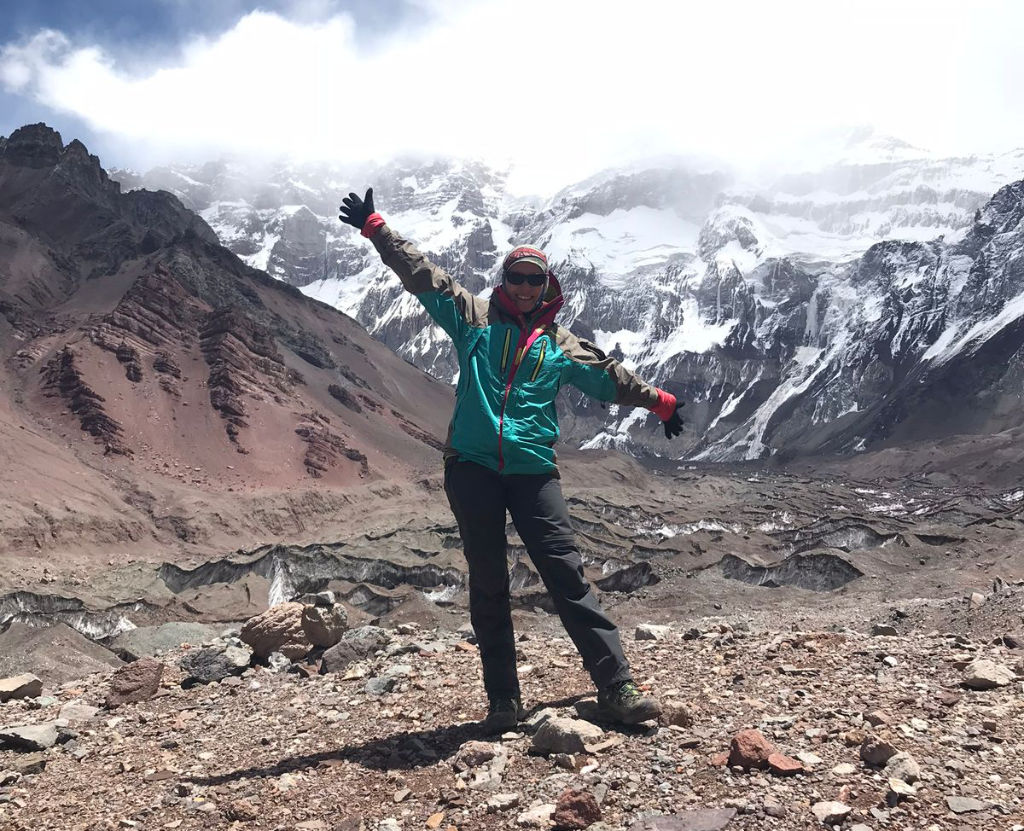
Plaza Francia – Photo: Fernanda May
Acclimatization: the Main Challenge of Climbing Aconcagua
Fernanda May, high-altitude athlete and sports physician
Dealing with the lack of oxygen due to altitude is one of the greatest challenges in high mountain environments. That’s why, during the expedition, agencies implement an adaptation process with trekkers at the beginning of the route, so they reach the main destination—the summit of Aconcagua—more comfortably. Preparation involves ascending as high as possible, then descending the same route to spend the night at an altitude already adapted to by the body.
According to Fernanda May, although expeditions offer efficient techniques to help visitors adjust to a hostile environment, acclimatization is personal and everyone reacts differently. “Acclimatization is a lottery. Some people are genetically more adaptable, while others are not. Expedition guides consider an average timeframe that most people need to acclimatize to each mountain, based on altitude.”
As there’s no way to train for acclimatization before the expedition, the mountaineer and physician recommend that those planning to climb Aconcagua have prior experiences to understand how their body reacts and to develop strategies that improve acclimatization during the expedition. “Ideally, you should have experience on lower mountains, but always above 4,000 meters, where you begin to understand how your body responds. Most altitude symptoms usually start between 3,500 and 4,500 meters.”
Amauri Coutinho, founder of Latitude 51, a mountain guide since 2014 with a postgraduate degree in physical education, points out that he faced significant acclimatization issues on Aconcagua because he hadn’t previously tested his body’s response to altitude. “That was my biggest mistake. I hadn’t exposed myself to thin air before, and after 5,200 meters, my metabolism shut down. I always recommend that people climb mountains in the 5,000 to 5,500-meter range before attempting Aconcagua to understand the effects of low-pressure and thin air at that altitude. Otherwise, you might feel frustrated and not want to pursue other high-altitude experiences.”
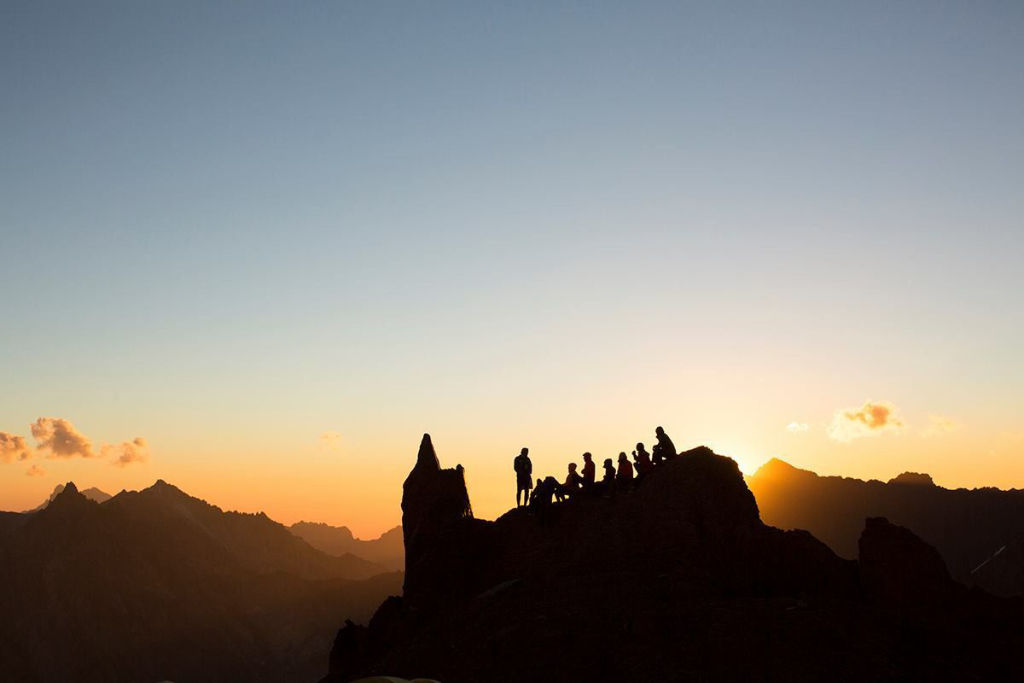
Camp 1 “Plaza Canadá” (5050m) – Aconcagua – Photo: Fernanda May
One important point that all travelers must keep in mind is to respect what specialists call active rest practice, which means staying moderately active, so the body can gradually adjust to the lack of oxygen. “It’s common for people to feel good at a certain altitude and, due to the excitement, want to explore the unknown area, which, besides exhausting them, increases the chances of developing altitude sickness, which usually appears around the third or fourth day,” explains Fernanda.
What Can I Do If I Take Longer to Acclimatize?
The specialist explains that, in this case, the person has two options: climb a slightly lower mountain before the expedition to acclimatize and be better prepared, or hire a private guide. “People who have significant difficulty acclimatizing are very likely to feel frustrated during an expedition—not because they’re incapable, but because they simply need more time to reach the summit. It’s important to identify what is limiting you and work on improving it.”
How to Prepare Physically and Mentally for Aconcagua
Fernanda May, mountaineer and sports physician
If you’re planning an expedition to Aconcagua, your first step should be to ensure your health is in good condition to face the challenges of high-altitude mountaineering. Sports physician Fernanda May advises mountaineers to consult a healthcare professional at least six months in advance to ensure better performance at altitude. “I often see vitamin and iron deficiencies in lab results. It’s impossible to recover from those deficiencies in a short time, even with supplements and proper nutrition.”
In addition to lab tests and the exercise stress test, which is often required by travel agencies, Fernanda also recommends undergoing an ergospirometry test. This test evaluates arrhythmias, heart problems, overall fitness level for this type of activity, and respiratory function. “The cold and dry air in high-altitude environments can trigger asthma attacks and high-altitude bronchitis, which is an inflammatory reaction in the lungs. It requires a lot of attention.”
The specialist emphasizes that preparation for Aconcagua is a team effort and that the medical check-up also helps guide the planning of physical training and nutrition before the expedition. “Based on the test results, I can work with a physical trainer, for example, to develop a training progression, so the person builds the necessary conditioning to climb Aconcagua.”
The medical consultation is also important for identifying vaccines and medications you should bring. This way, you’ll receive guidance on what you can use and what procedures to follow during the expedition, in case of need.
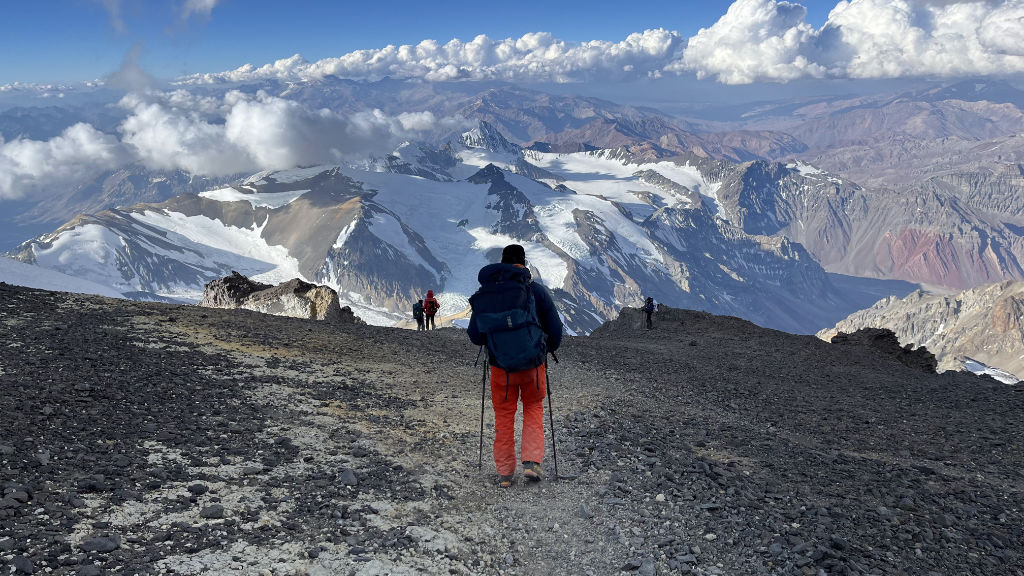
Photo: Bruno Alvarenga
Physical Training for Aconcagua
Success in reaching the summit of high-altitude mountains depends on not overlooking any aspect of preparation, and physical conditioning is one of the most important. While each mountain requires specific preparation, all demand strong cardiovascular and muscular conditioning for long hikes, climbs, and descents. You’ll need strong legs, back, and core to endure the days on expedition—also considering the weight of your backpack.
Ilan Zeimer, lead guide at Grajales Expeditions with 22 years of experience (guiding since 2002, with 58 successful Aconcagua summits), points out that lack of preparation is one of the main reasons many people fail to reach the summit. “In all these years guiding on Mount Aconcagua, I’ve witnessed a surprising trend. Each year, climbers from all over the world and all walks of life arrive in South America to take on this high-altitude challenge. However, few prepare adequately. Many are, undoubtedly, physically fit individuals, but few have trained specifically for the unique demands of ascending for 11 days across rocky terrain.”
Fernanda May, who summited both Aconcagua and Denali, recalls that during her expedition, there were participants with varying levels of mountaineering knowledge. She mentions that two members had only experienced high-altitude trekking in the Atacama Desert—a very different environment from Aconcagua.
“They struggled from beginning to end and didn’t make it to the summit. For them, the experience—both personal and financial—was quite negative. They had trouble acclimatizing, and due to a lack of technical skills, they slipped frequently on the ice, which hindered their progress. That’s why it’s essential to gather information about the season and not underestimate the activity. Others in my group also failed to summit because of the intense cold, which demanded greater effort since we couldn’t stop to rest during the climb.”
Cardiovascular and muscular reinforcement to climb Aconcagua
To ensure success from start to finish of the expedition, Fernanda emphasizes that uphill and downhill training is essential to strengthen the muscles. According to her, maintaining proper physical conditioning and robust muscle mass also helps the body recover more quickly after the expedition, avoiding a drop below the healthy muscle mass threshold. “Muscle mass must be reinforced, considering that there is loss during exposure to intense cold and lack of oxygen. The metabolism speeds up so much that we enter a state called catabolic, which stimulates, mainly due to the cold, the breakdown of protein and, consequently, muscle loss.”
To improve his aerobic and cardiovascular capacity to face the lack of oxygen, Amauri Coutinho, who has accumulated experience on several mountains, says he trained for a year in the Serra Fina region, in Passa Quatro, Minas Gerais. Living in São Paulo, he traveled there two weekends per month and spent two to three days climbing Pedra da Mina, the fourth highest mountain in Brazil, at 2,798 meters above sea level, carrying a heavy backpack.
Food routine: what to eat before and during the expedition to Aconcagua
Anyone planning to climb Aconcagua must pay close attention to nutrition, considering not only the duration and intensity of each expedition day, but also a key factor that sets high-altitude mountaineering apart from other outdoor activities: altitude.
To compensate for the lack of oxygen, heart rate and breathing go through an acceleration process, which results in greater energy consumption in addition to that spent during hiking and recovery from a day on the mountain. “Considering this factor in nutritional planning is essential to preserve muscle mass, endurance, and physical conditioning,” explains Homero Munaretti, a nutritionist specialized in adventure sports and mountaineering.
According to the expert, the ideal way to increase your chances of summiting Aconcagua and returning from the expedition in good health is to plan 3 to 4 months in advance. “Nutrition helps enhance the training phase, providing nutrients for muscle gain and physical conditioning, as well as minimizing the chances of injuries during the expedition. The sooner you seek nutritional guidance, the better it will be to develop effective food strategies during the journey.”
Pre-Expedition Nutrition
The nutritional support process to ensure performance and preserve the body during the Aconcagua expedition follows four stages:
Initial Assessment
Just like the medical guidance recommended by Fernanda May, Homero’s process begins with analyzing lab tests to evaluate not only overall health but also how well your body is likely to adapt to high-altitude environments. “In women, for instance, there are many cases of iron deficiency, which is essential for the formation of red blood cells—responsible for oxygen transport and, therefore, acclimatization.” Eating habits are also evaluated to correct any mistakes. “I often notice that many people consume fewer carbohydrates than they should, considering their training load, which hinders muscle fiber development and places greater stress on the body.”
Adaptation Phase
The second step is adapting your preferred foods according to what’s available in high-altitude environments. “Tea, for example, helps warm and hydrate the body, but if you don’t like it, we’ll find an alternative. Whey protein and bars are also recommended, but we need to identify, for instance, which flavors you enjoy.” According to Homero, the goal of this phase is discovery—testing what works and presenting tactics that can be applied during the expedition.
Diet Adjustment
This stage involves strategies such as increasing carbohydrate intake for a period, as they are the main source of fuel for high-altitude expeditions. “At this point, we evaluate your appetite and how your body reacts to increased intake of bread, pasta, and other high-volume foods.” This phase also includes evaluating how well your digestive system absorbs nutrients.
Loading
Close to the expedition, around three days before departure, it’s time to implement what Homero calls carbohydrate loading—to increase energy stores—as well as increasing protein and fat intake to maintain the body and ensure you arrive at Aconcagua with maximum energy.
Nutrition During the Expedition: What and How Much to Eat
Homero Munaretti, a nutritionist specializing in adventure sports and mountaineer
To plan the best diet for the expedition, Homero says it’s essential to consider the logistics of the company leading the trek to create a viable strategy. “We assess the infrastructure, the general and daily duration of the expedition, the route, the food offered, the intervals, and the weight each person will carry in their backpack to build a mountain-specific nutrition plan.”
For the specialist, common sense is key when it comes to food in remote areas. “We must respect the hostile environment you’ll be exposed to, where resources are limited and where unforeseen events—such as a sudden weather change—can force you to remain in the tent longer.”
Daily Planning
Homero recommends starting the day with a large dose of carbohydrates for energy, a sufficient amount of protein to maintain muscle mass, and at least 500 ml of water.
During the activity: the number of nutrients consumed during the Aconcagua expedition will depend on the duration and intensity of the hike. “The hike to Plaza de Mulas, for example, is considered light and does not involve much altitude exposure, so the body will be more stable.”
According to Homero, nutrition protocols recommend consuming between 20 and 90 grams of carbohydrates every 90 minutes, depending on the intensity of the activity. Here again, common sense is needed: “We need to evaluate what’s feasible. I don’t want you to eat everything in your backpack all at once. So, we optimize the quantity, prioritizing the minimum recommended intake during the lighter stages to maintain blood glucose and energy.” In addition to carbohydrates, it’s recommended to include 3 to 4 grams of protein to help preserve muscle from excessive stress.
Regarding hydration, Homero says that protocols recommend 500 ml to 1 liter of water per hour of hiking, which—considering a mountain environment—is unfeasible unless you cross several rivers or waterfalls. “We repeat the adaptation process, aiming for a minimum of 100 ml to 500 ml per hour, depending on availability, to improve food absorption, with 500 ml being ideal.”
After the activity: once you arrive at camp to rest, food plays a key role in quickly recovering the body, since the next day’s high-mountain routine will continue. It’s recommended to consume within four hours after the activity about 1 gram of carbohydrate per kilogram of body weight and 0.4 to 0.8 grams of protein per kilogram of body weight. So, if you weigh 70 kg, the ideal is to consume 70 grams of carbohydrates and at least 30 grams of protein.
Dinner: according to the specialist, dinner can be lighter, with 40 to 50 grams of carbohydrates and 20 to 30 grams of protein. The fats present in these foods act as a caloric complement. Homero emphasizes that even if you’re exhausted when you reach camp, you must eat—otherwise your body won’t recover properly for the following days.
Nutritional Supplements: Practicality and Energy at High Altitude
Just as proper food boosts training results and provides energy during the expedition, supplements also help optimize performance and support muscle recovery. Plus, they’re convenient to carry in your backpack.
Protein powder, for example, aids in muscle recovery after strength training. Victor Castello Branco, founder of Z2 Foods, recommends the Recovery Mix. “It was developed to optimize muscle recovery, as it contains 20 grams of high-quality protein and 10 grams of fast-absorbing carbohydrates.” On the other hand, creatine, according to Victor, can increase muscle strength and power.
The daily number of supplements should be adjusted according to individual needs and with professional guidance. If you’ve never used supplements in your diet, it’s recommended to start at least 8 to 12 weeks before the expedition, so your body can adapt and you can fully benefit from them during physical preparation. This period is also used to train the gut to tolerate carbohydrates during workouts in the form of gels, food, or drinks.
Which supplements to use during the Aconcagua expedition:
- Energy foods: energy bars, gels, and carbohydrate drinks to maintain energy. Examples: Energy Gel and Power Powder.
- Protein for muscle recovery and satiety. Example: Recovery Mix.
- Electrolytes for hydration. Example: Saltz.
Prepare Your Mind to Handle Discomfort
Freezing and altitude are the main psychological challenges faced by Aconcagua expedition participants. Consequences include poor sleep, loss of appetite, and other altitude sickness symptoms.
Fernanda shares that she experienced a temperature of -12ºC inside her tent. “If you’re cold day and night and can’t eat properly, everything works against your mental state. Many times, the psychological challenge is tougher than the physical one in high mountains because we rely mostly on endurance and mindset. Our body can go much further than we think—if the mind is prepared.”
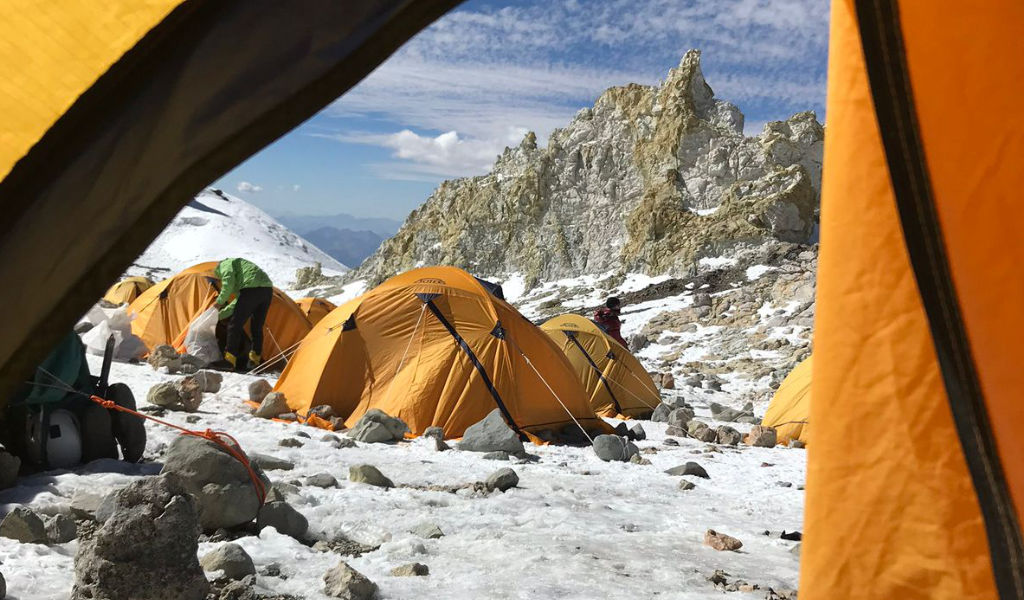
Plaza Cólera Camp (5970m) – view from inside the tent. Photo: Fernanda May
A good way to prepare for the discomforts of high altitude, according to her, is to expose yourself to uncomfortable situations in advance. “You must train your mind by doing long activities in uncomfortable conditions. Linking treks together is one strategy I recommend. If a trail normally takes two or three days, pack light and do it in one, walking for 13, 14, 15 hours. There’s no comfort in that! But it helps train your psychological resilience because on summit day you’ll be active for 12 to 18 hours without stopping. Your mind has to be ready for that.” Another tip from the mountaineer and physician is to run in the rain during training.
Amauri Coutinho also emphasizes the importance of exposure to discomfort as a form of preparation. “We’re used to shorter training sessions. I suggest extending them to 4 or 5 days in uncomfortable conditions because that’s when you’ll feel many of the symptoms caused by altitude. If, about three months before your expedition, you can take two to three weeks to experience this, you’ll be much better prepared. You need to live with discomfort for several consecutive days—because there will be more than 10 tough days. There’s no break!”
Another important point raised by the founder of Latitude 51 for maintaining mental strength is to avoid comparing yourself to others. “Reaching the summit of Aconcagua is a competitive activity. You’ll meet teams from the U.S., Italy, Spain, and as a Brazilian, you might get street dog syndrome’ and feel inferior. The key is to stay focused and committed to your own group.”
Team spirit is also highlighted by Fernanda as an essential part of reaching the summit. “It’s fundamental that the group stays united and uses common sense to support those who face more challenges.”
Technical Skills Needed for the Aconcagua Summit Push
In addition to physical and mental preparation, being in a remote and hostile environment means you must be minimally equipped to face adverse situations, reduce accident risks, and have a positive experience.
As mentioned earlier, the main challenge in summiting Aconcagua is the altitude. The most popular routes, according to Fernanda May, while demanding in terms of physical fitness, do not require advanced climbing skills—but you must assess the seasonal conditions for your planned expedition, as they vary each year.
When snow is dominant, it’s necessary to use crampons and have the technical skills to ascend safely and efficiently. “The Canaleta section, for example, although short, is quite steep and, when icy, requires proper technique. Without it, you may struggle—crampons can get tangled, causing falls. Snow makes the climb more demanding.”

La Cueva (6,650m) – Aconcagua – Fernanda May
How to Move Properly with Crampons
Your legs must remain apart to avoid catching one crampon on the other—or on your pants—which increases the risk of falling and injuring yourself or others. The steeper the terrain, the more skill you’ll need to walk with crampons attached to your boots.
Bruno Alvarenga participated twice in the Aconcagua expedition, and during his first attempt, he didn’t reach the summit due to several factors—one of them being a lack of skill with crampons. “While walking, they kept coming loose, which was a big issue. Only after I returned to Brazil did I realize the problem could have been fixed with a simple adjustment. I bought the gear for the expedition but hadn’t tested it on mountains before. It caused a lot of fatigue because I had to stop often to adjust them, and putting them on took effort—consuming even more energy at altitude.”
Before heading out, check with your travel agency if they offer pre-expedition training in crampon technique to ensure safe use.
How to Use an Ice Axe
Used for ice climbing, the ice axe (or ice tool) is an essential piece of equipment in mountaineering and ice climbing. It consists of a long handle, usually made of lightweight metal or fiberglass, with a metal head that has a sharp pick on one end and a small adze or hammer on the other. The ice axe provides support and safety on steep, snowy terrain, assisting in traversing and climbing icy slopes. Additionally, in the event of a slip, you can drive it into the snow to secure yourself.
The appropriate model is the mountaineering or trekking type, and its use requires proper technique—just like crampons, it’s a sharp-edged tool that can cause accidents if misused.
Some mountain-oriented courses teach how to use this tool effectively and safely.
Gear and Technology: What to Bring on the Aconcagua Expedition
Knowing your own body in advance helps you choose the right gear and manage the weight you’ll carry on your back. That’s why it’s important to understand how your body reacts to prolonged exposure to freezing before packing your backpack for the Aconcagua expedition.
Choosing inadequate clothing or gear can increase discomfort and lead to serious health problems due to extended exposure to freezing. These may include frostbite on feet, fingers, hands, nose, and ears, and hypothermia, where body temperature drops below 35ºC. Therefore, choosing your gear carefully is crucial for an Aconcagua expedition.
We’ve prepared a checklist to provide an overview of the necessary gear, including examples of essential items. However, there are many individual considerations to ensure a successful expedition. It’s also worth noting that there’s a wide variety of models and brands for the items mentioned, which will not be addressed in this article.
The following list does not include group equipment such as tents and cooking utensils, as these are typically provided by the expedition agencies.
1. Layered Clothing
One of the defining features of climbing Aconcagua is dealing with vastly different climates and temperatures. During the approach, temperatures can reach as high as 30ºC, while on summit day, they can drop to -40ºC. Therefore, the clothing you’ll use varies greatly.
The most important thing in high-altitude expeditions is understanding the Layering System, regardless of when you’re wearing the clothing:
1st Layer: everything in direct contact with your body. Its purpose is moisture management—basically, to move sweat away from the skin. But there are nuances. In hot climates, the goal is to evaporate sweat quickly to cool the body. So the first layer in warm conditions should maximize heat loss through evaporation. In cold weather, the fabric should both manage moisture and retain warmth, minimizing heat loss through conduction. If your skin stays wet, you’ll lose heat rapidly through water.
2nd Layer: this layer focuses on thermal regulation—retaining the heat generated by your body. Generally, this includes fleece jackets or insulated jackets (with synthetic or natural fill, such as goose down or merino wool). During the approach, a fleece may be sufficient, but for the summit, a down jacket is essential. Down is more efficient and compressible than synthetic fill, which is why it’s often preferred. However, down quality varies, and this should be considered.
3rd Layer: the outermost layer protects against natural elements like rain, wind, and snow. In dry climates such as Aconcagua, it is primarily used as wind protection.
The same layering system should be applied to protect your legs from the cold.
2. Footwear
To avoid discomfort, it is recommended to use comfortable boots that have been broken in beforehand. One tip from Fernanda is to buy one size larger than usual, since you’ll be wearing thicker socks due to the cold. “The tighter your boots are, the poorer the blood circulation—and that makes your feet colder.”
Double boots are also recommended, although purchasing them can be a significant investment. That’s why renting a pair is an option, especially if you’re just starting out with high-altitude mountaineering. Fernanda recommends the brand La Sportiva, which ensures comfort and safety.
Tip: when renting or buying any boot model, in addition to trying them on, it’s best to walk up and down a few steps to ensure they’re neither too tight nor too loose. This prevents heel lift while walking for hours, which can cause blisters or even injuries. You should also check if any area of the boot causes discomfort—this allows you to protect that spot with small bandages before it becomes a problem.
Amauri recalls that he invested in high-end gear for his Aconcagua expedition but borrowed a friend’s double boots, which caused him discomfort during the trek due to lack of prior experience with that footwear.
3. Accessories
Gloves and socks: it’s essential to keep your hands and feet warm during the expedition. Miton gloover are widely used in high-altitude mountaineering.
Sunglasses and goggles: the sunglasses should be wraparound to protect your eyes from solar reflection and glare, which can cause temporary vision loss due to the intense light. Goggles are recommended for snowy or windy conditions.
Neck gaiters and caps: useful not only for warming the neck, but also for covering the face to protect it from cold and dry air. Used to summiting high-altitude mountains, Fernanda even uses neck gaiters as balaclavas to moisten her breath without having fabric stick to her face—and also on her hands to deal with nasal discharge, which is common on expeditions, without irritating her nose.
4. Equipment
Trekking poles, crampons, and ice axes: poles are extremely helpful on long expeditions because they help conserve energy by distributing backpack weight between the upper and lower body. Crampons are necessary for walking on hard ice, and ice axes are used for ascending steep snow or ice.
Helmets: climbing helmets are mandatory in sections with rockfall risk.
The Importance of Choosing a Proper Sleeping System for Climbing Aconcagua
Climbing Aconcagua—the highest mountain outside Asia—is an extreme challenge that demands meticulous preparation and proper equipment. One of the most critical parts of that preparation is selecting the right clothing and sleeping system. Due to the harsh environmental conditions—extremely low temperatures and strong winds—ensuring safe and comfortable sleep is essential for both success and safety during the expedition.
Sleeping Bag for Extreme Temperatures
A sleeping bag suitable for extreme temperatures, such as the Alpine by Sea to Summit, is essential. Aconcagua is known for nighttime temperatures that can easily drop below -20°C. The Alpine offers superior insulation, keeping the body warm even in the harshest conditions. Its construction uses high-quality materials, such as 850+ goose down fill, which provides excellent heat retention without adding excessive weight to your pack. Additionally, the shape and design of the sleeping bag are optimized to minimize heat loss and maximize comfort, ensuring you can rest properly between trekking days. The model has a comfort rating of -19°C and a limit rating of -29°C.
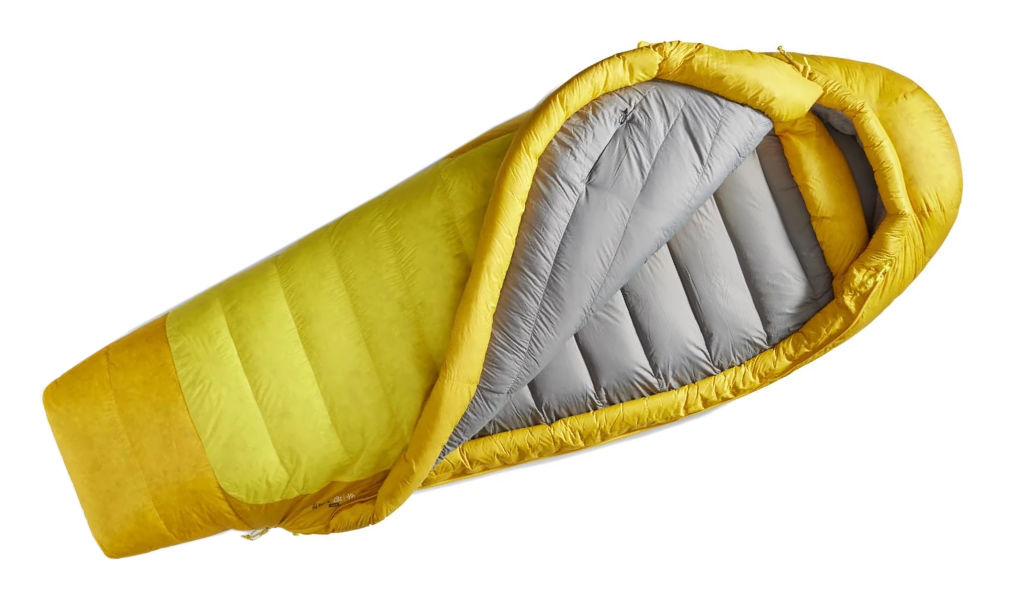
Sleeping Pads
In addition to a high-performance sleeping bag, using proper sleeping pads is equally important. A good combination is a closed-cell model like the Odin by Azteq, along with a high-performance inflatable pad like the Ether Lite XT Extreme by Sea to Summit, which together ensure effective thermal insulation.
Odin Sleeping Pad by Azteq
The Odin sleeping pad by Azteq is designed to be placed underneath the inflatable pad, providing an extra layer of protection against ground cold. Made from closed-cell foam, the Odin is lightweight, durable, and effective at preventing heat loss. This extra layer of insulation is crucial to block ground cold from seeping through the inflatable pad, creating an effective barrier between your body and the icy surface. Additionally, this type of pad helps prevent punctures and damage to the inflatable pad during the expedition.
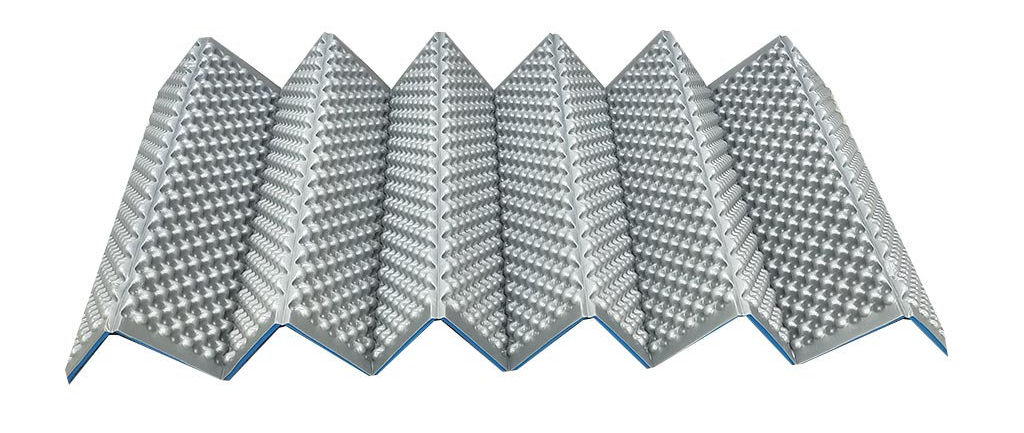
Ether Lite XT Extreme inflatable sleeping pad, by Sea to Summit
The Ether Lite XT Extreme, by Sea to Summit, is an inflatable sleeping pad with an R-value of 6.2, which indicates its superior thermal insulation capacity. With a robust construction and high-quality materials, it offers excellent comfort and protection. Its thickness and structure ensure that body heat is retained and evenly distributed.
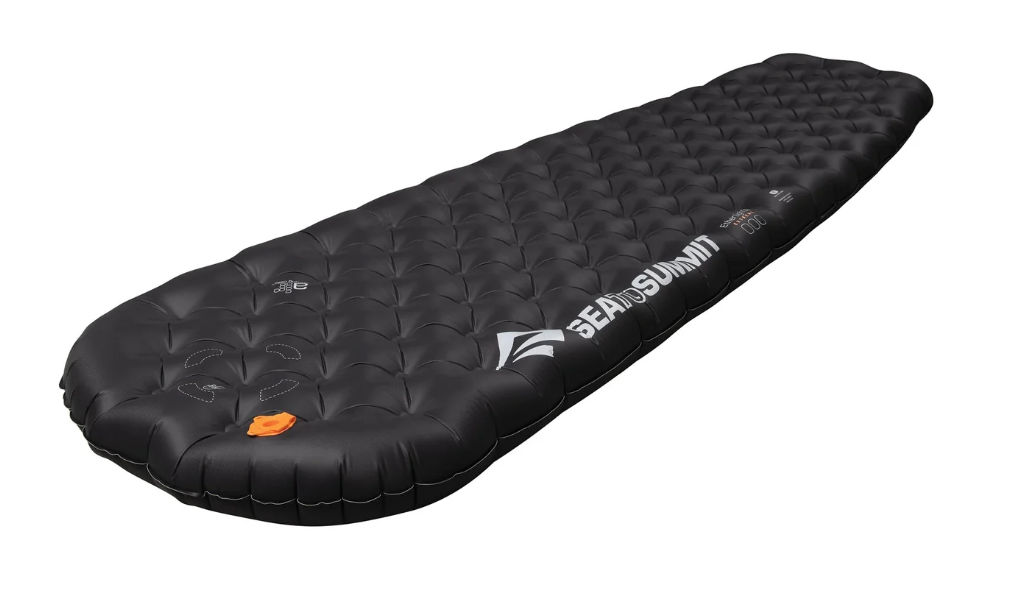
Conclusion
Choosing the right sleep system is vital to face the challenging conditions of Aconcagua. A sleeping bag for extreme temperatures like the Alpine, by Sea to Summit, combined with a thermal insulation system such as the Odin, by Azteq, and the Ether Lite XT Extreme by Sea to Summit, offers the protection and comfort necessary to ensure proper rest. Restorative sleep not only keeps energy levels and morale high, but it is also crucial for acclimatization and the ability to make safe decisions in a hostile environment. Investing in a high-quality sleep system is investing in the success and safety of your Aconcagua expedition.
Backpacks
During the Aconcagua expedition, you will need two backpacks: a robust expedition pack for carrying gear during the ascent, and a smaller, lighter backpack for the summit push.
Choosing the ideal model should consider comfort so as not to strain your shoulders during the long trekking days, with padded back panels, shoulder straps, and hip belts. Fernanda recommends a 50-liter backpack if you are not carrying your own gear. Otherwise, she suggests a 70-liter model. The mountaineer also notes that backpacks help protect your back from the cold.
Expedition backpack: Deuter Aircontact X 70+15
To carry all the necessary gear to the base camps, choosing an expedition backpack is essential. The Deuter Aircontact X 70+15 (or similar volumes, depending on each person’s gear) is an excellent option, offering robustness and sufficient capacity for the expedition. With a total expandable volume of 70+15 liters, the backpack can accommodate all the necessary equipment, from extra clothing to personal kitchen utensils and safety items.
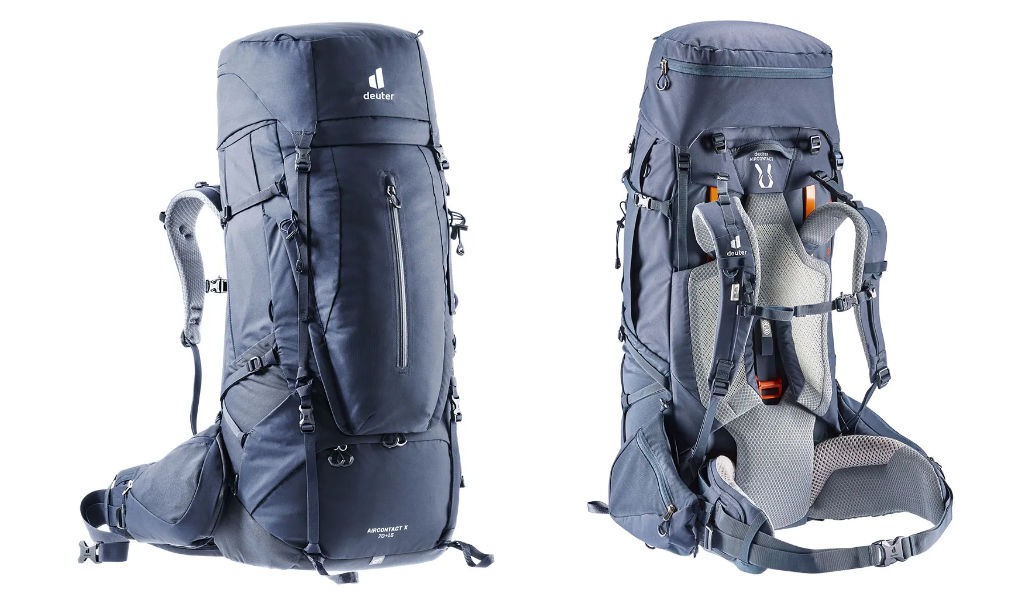
Load Capacity and Comfort
The Deuter Aircontact X 70+15 is designed to support loads of up to 30 kg, ensuring excellent weight distribution and comfort during long hikes. While an expedition participant usually doesn’t carry that much weight, the extra capacity provides an important safety margin. The backpack’s load transfer system (shoulder straps, back panel, and hip belt) ensures a comfortable fit and reduces pressure on the shoulders and spine, allowing for a more efficient and less exhausting hike.
Durability and Resistance
The ruggedness of the Deuter Aircontact X 70+15 is another crucial factor. Made with high-quality, durable materials, the backpack is capable of withstanding the harsh conditions of the mountain, including extreme temperatures, humidity, and abrasion. Its durability prevents failures at critical moments, providing confidence and safety to the climber.
Summit push backpack: Deuter Gravity Expedition 45+
For the summit push, it is essential to use a smaller and lighter backpack that allows for greater agility and efficiency. The Deuter Gravity Expedition 45+ is ideal for this phase of the climb, offering the perfect balance between lightness and capacity.
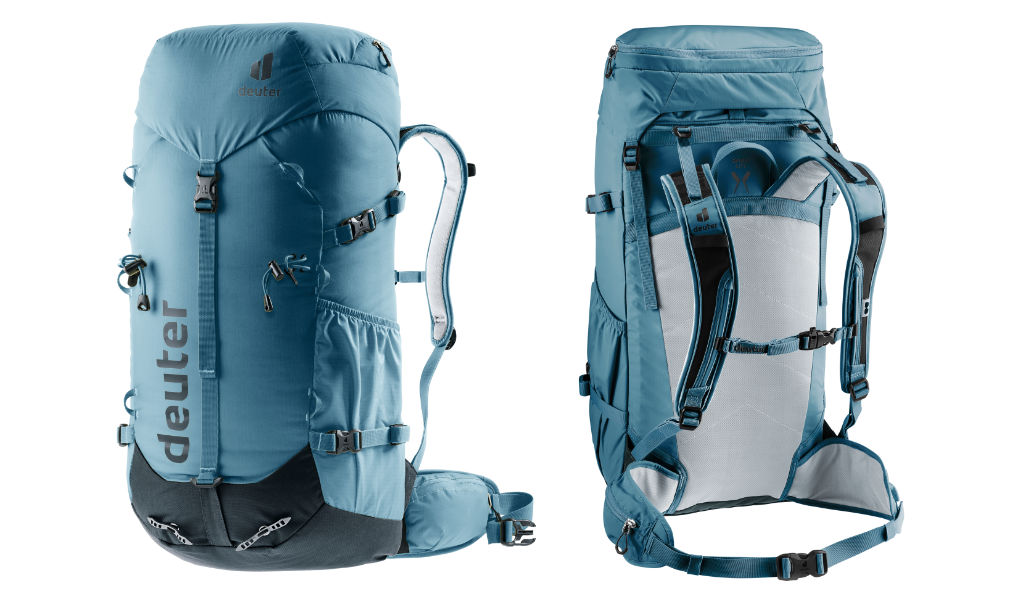
Lightness and Versatility
With a volume of 45+ liters, the Deuter Gravity Expedition 45+ is spacious enough to hold extra clothing, food, water, and other essentials for the summit push, without adding unnecessary weight. Its lightweight construction allows the climber to move more freely and quickly — crucial factors during the final ascent.
Functional Design and Comfort
The backpack features an ergonomic design that ensures comfort, even in extreme conditions. The padded straps and ventilation system keep the climber comfortable and dry, while the well-organized compartments allow quick access to necessary items. Additionally, the durability of the Deuter Gravity Expedition 45+ ensures it can withstand the demands of rocky terrain and harsh weather.
Conclusion
Choosing the right backpacks for climbing Aconcagua is vital for the safety and success of the expedition. The combination of a rugged expedition pack like the Deuter Aircontact X 70+15 and a lightweight summit pack like the Deuter Gravity Expedition 45+ provides the versatility, comfort, and durability needed to face the challenges of the mountain. With these backpacks, climbers can focus on the ascent, confident that their gear is secure and accessible throughout every phase of the expedition.
5. Technology
Being in a hostile environment—typical of high-altitude expeditions—makes us much more vulnerable. Therefore, investing in safety is essential. In places like Aconcagua, location tracking is done via satellite. While popular mountain routes such as Aconcagua’s are often well-marked, making it hard to get lost, satellite tracking is an excellent resource in case of emergency and also allows communication with friends and family—even in remote areas.
5 Features of the SPOT Gen4
Tracking Mode: the device sends your location via satellite every 10 minutes (you can set your preferred interval). Through a shared map link, others can follow your progress in real time.
Predefined Message: allows you to create preset messages and register contacts who will receive both your message and exact location.
Check-in: when you finish your day’s hike, you can send another message upon arriving at camp.
Help Message: you can alert personal contacts if you need assistance. This function is meant for non-life-threatening situations.
SOS: by pressing the SOS button, FocusPoint International, Inc. provides emergency rescue coordination and monitoring through its dedicated search and rescue coordination centers. The SOS button should only be used in life-threatening emergencies.
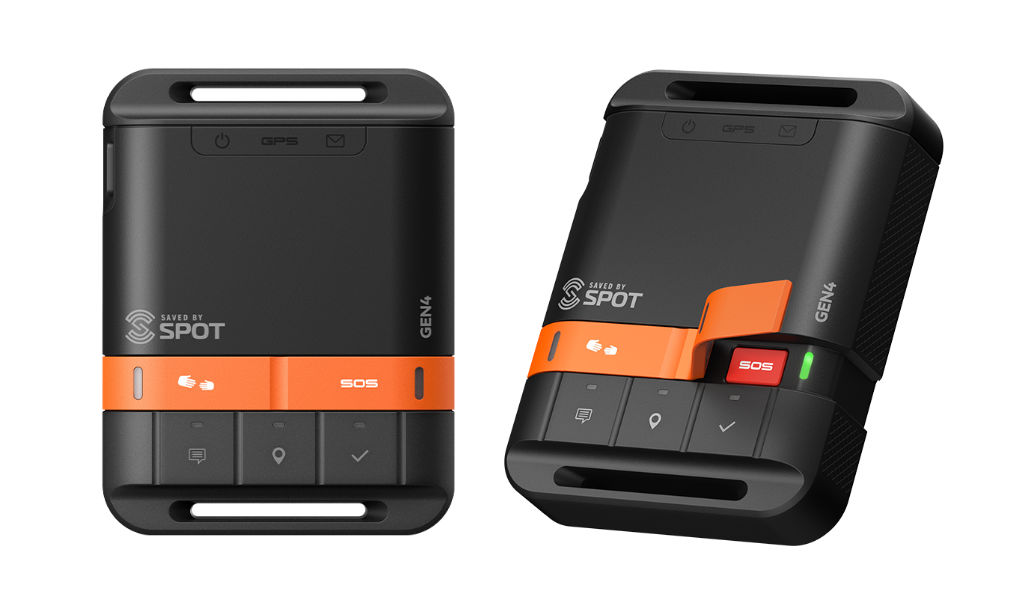
6. First Aid Kit
- Basic items for any outdoor activity: common medications such as pain relievers, anti-inflammatories, antihistamines, and materials for wound care and splints for immobilization in case of sprains.
- Specific items for high-altitude environments like Aconcagua: the kit must be reinforced, considering the lack of infrastructure, altitude, and exposure to intense cold, which can cause everything from headaches, sinusitis, appetite loss, and nausea—considered common symptoms—to pulmonary and cerebral edema if you are not well-equipped and prepared. Ideally, you should get professional medical advice to bring medications that help alleviate the effects of altitude. Fernanda May recommends that her patients carry, in addition to the items listed above, corticosteroids for allergic reactions and potential altitude-related issues.
Another tip from the sports physician is to bring saline solution (liquid or spray) to protect nasal mucosa and lips from the freezing and dry air.
Sustainability on Aconcagua
Every summer, over 5,000 people arrive in southern Mendoza to visit Aconcagua—a significant number for local tourism, which benefits mountain guides, porters, camp managers, muleteers, and other specialized service providers.
Supporting the local community and preserving natural resources ensures that Aconcagua remains accessible to those who practice outdoor activities. For that reason, there are two key points to keep in mind when visiting this destination.
Check out these tips to ensure a positive experience while benefiting the local environment:
1. Follow the Leave No Trace principles
Below are two of the seven Leave No Trace principles to apply during your expedition to Aconcagua:
Dispose of waste properly
In high-altitude environments, access to toilets and trash bins is limited or even nonexistent. On the Aconcagua expedition, waste must be placed in designated containers located at the base camps and high-altitude camps.
The agencies are responsible for collecting all the waste and carrying it down the mountain. To ensure everything goes smoothly, and the environment is preserved, you just need to follow the guides’ instructions carefully.
The same applies to human waste. At Plaza de Mulas, there are barrels that serve as toilets for solid waste, which are periodically removed by helicopter. During the ascent, agencies are responsible for collecting the waste.
Respect the animals
Every day, it’s common to see mules traveling from morning until early afternoon along the trail that starts at the park entrance and passes through Confluencia to Plaza de Mulas. These animals transport supplies and climbers’ gear. The recommendation is to keep a respectful distance and avoid feeding them, allowing them to roam freely in their natural environment.
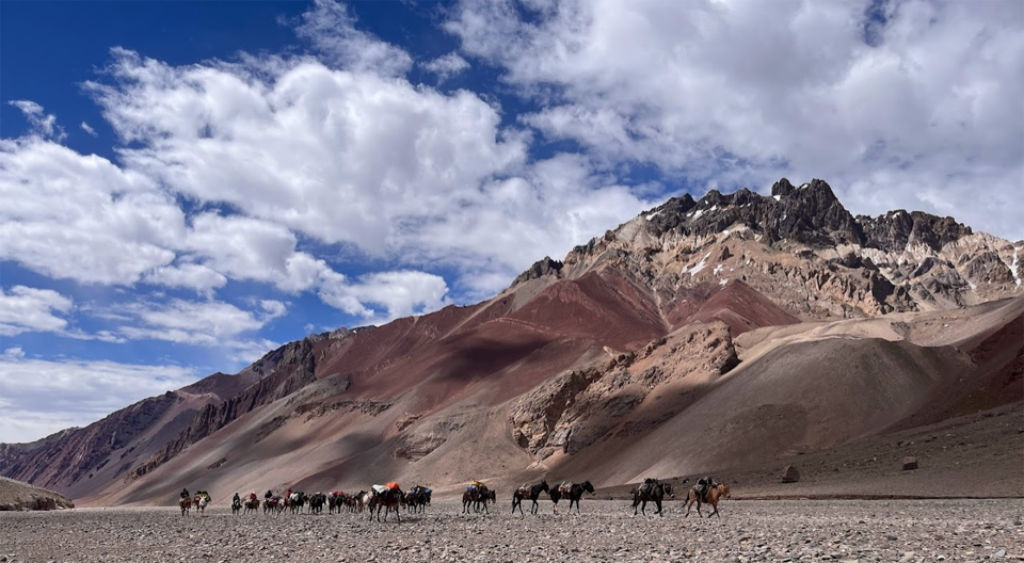
Photo: Bruno Alvarenga
Choose Environmentally and Socially Responsible Companies
To minimize the environmental impact of its operations, Grajales Expeditions uses solar panels at all its base camps, providing clean energy and avoiding the use of diesel generators.
Additionally, since 2004, the company has separated waste generated during Aconcagua expeditions for recycling. By doing so, it respects the environment and supports a local cooperative in Mendoza called “Los Triunfadores.”
Formed by nine women and one man, the cooperative currently separates over 30 types of waste—such as paper, cardboard, metals, and cans—for recycling. It also maintains a space dedicated to childcare and education, where children can stay after school and receive homework assistance, for example.
Grajales was also the first company to donate 1% of its revenue to the NGO “1% for the Planet“, which invests in environmental conservation projects.
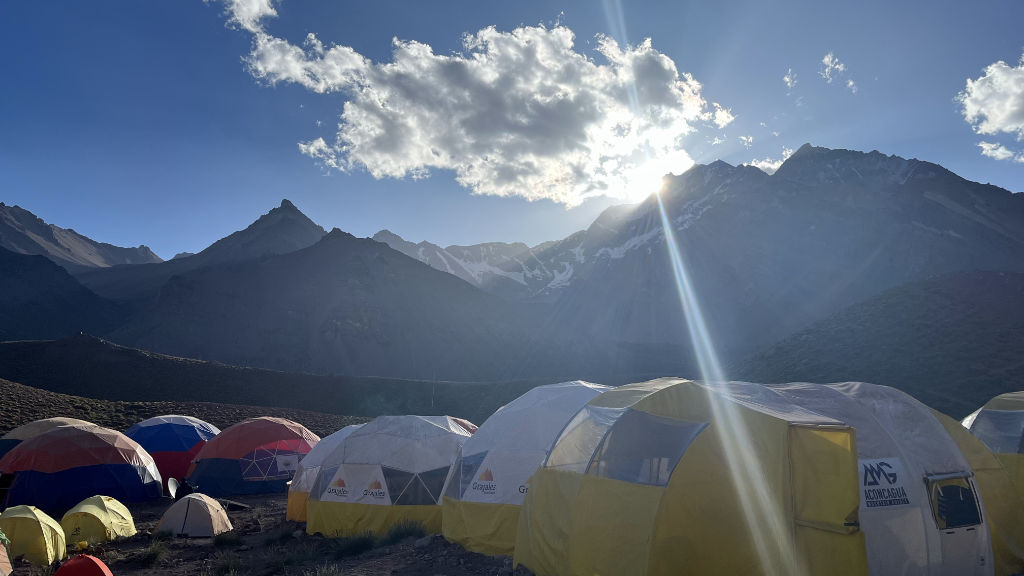
Grajales Expeditions tents – Photo: Bruno Alvarenga
How to Choose an Agency for Your Aconcagua Expedition
All the variables involved in the great challenge of reaching the Aconcagua summit—such as altitude, unpredictable weather, and preparation for each day—require the support of specialized professionals who can ensure safety and comfort throughout the expedition.
Despite the abundance of offers on social media and the internet, it’s crucial to make sure the company operates ethically and professionally. You should also objectively review its track record, consult client reviews and testimonials online, and seek referrals from friends.
The Importance of Being Well Accompanied in High Mountains
Bruno Alvarenga went to Aconcagua twice—once in 2022 and again in 2024, when he successfully reached the summit after a frustrating experience two years earlier, largely due to choosing a company that did not meet his expectations. He explains that, since he already had high-altitude experience, he chose a simpler agency that charged a lower fee. He and a friend joined a group of eight, led by a Brazilian guide and a local one.
Bruno recalls that during that season, they faced a very unfavorable weather window. While still at base camp, the group already anticipated that within 4 to 5 days, weather conditions would become highly adverse. “Strong winds were expected, along with overcast skies and snowfall.”
Given this forecast, the team met with the guides to decide on their next steps. The first option was to skip acclimatization stages and climb faster to take advantage of the few remaining good-weather days. The second was to stick to the original plan without rushing, hoping for an improvement in weather—with the risk of not even getting close to the summit. “The guide chose the second option, and we did an acclimatization hike on Cerro Bonete, just across from Aconcagua. That day, as predicted, the weather started to shift.”
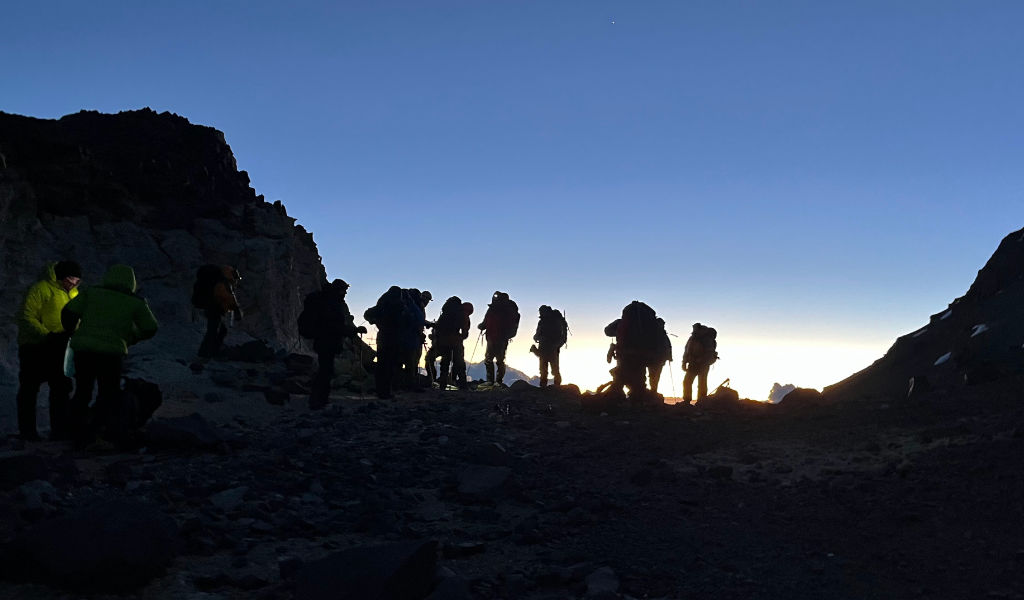
Piedras Blancas (6,060 m) – Aconcagua. Photo: Bruno Alvarenga
In addition to strong winds, lightning struck the team’s route. One of the guides was hit and suffered a second-degree burn on his foot. After the scare, the group returned to camp. “The sky was completely overcast—we had no visibility at all, just the sound of thunder very close by. We were near our goal but had to turn back. After receiving medical attention, the guide was advised to call off the expedition.”
For a second time, the group met to decide on a new strategy, as there was no viable summit window before the expedition’s end date. Bruno and two others decided to continue on their own and attempt the summit again, while the rest returned to Mendoza. Although they had the equipment and food left by the guides, they had to take full responsibility for cooking and making critical decisions without proper experience. The accumulated exhaustion and the absence of a professional guide ultimately made the summit attempt unfeasible. “My friends always joke that the cheap option ended up being very expensive.”
Grajales Expeditions: A Pioneer in Securing a License to Operate on Aconcagua
Grajales Expeditions is one of the largest companies conducting expeditions to Aconcagua. A Gear Tips Club partner, the agency has been operating since 1976 and has played a key role in the region’s development. The company was founded by Fernando Grajales, a pioneering mountaineer from Mendoza, known for carrying forward the mountaineering philosophy with professionalism and innovation. Read the full story of Grajales Expeditions.
Conclusion
Reaching the iconic summit of Aconcagua is a goal pursued by mountaineers from all over the world—but being well-prepared is essential to overcome altitude, cold, and rapidly changing weather conditions. Physical and mental preparation, as well as the choice of equipment and professionals to ensure safety during the expedition, are key to achieving your goal.
Gear Tips Club aims to bring together the best partners and offer a path of knowledge to ensure your outdoor experiences are always complete and rewarding. We provide our members with access to exclusive offers, content, and courses.
This post is also available in: Português (Portuguese (Brazil)) Español (Spanish)
